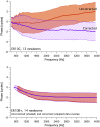Differences in distortion product otoacoustic emission phase recorded from human neonates using two popular probes
- PMID: 20649189
- PMCID: PMC2905449
- DOI: 10.1121/1.3453415
Differences in distortion product otoacoustic emission phase recorded from human neonates using two popular probes
Abstract
DPOAE (2f(1)-f(2)) phase was measured across a 3-octave frequency range from two groups of newborns using ER10B+ and ER10C probe microphones. A marked phase shift was noted in the mid-to-high frequency range for newborn data recorded with the ER10C only. In contrast, the ER10B+ produced phase that was approximately invariant as a function of frequency for most of the range. Probe-related phase shifts can be effectively eliminated by correcting for variations in the phases of the primary tones. Results highlight the importance of detecting and correcting for system-related phase shifts so they are not misinterpreted as cochlear in origin.
Figures




Similar articles
-
Wideband acoustic immittance for assessing middle ear functioning for preterm neonates in the neonatal intensive care unit.S Afr J Commun Disord. 2017 Jun 28;64(1):e1-e11. doi: 10.4102/sajcd.v64i1.182. S Afr J Commun Disord. 2017. PMID: 28697607 Free PMC article.
-
Investigation of a significant increase in referrals during neonatal hearing screening: a comparison of Natus ALGO Portable and ALGO 3i.Int J Audiol. 2012 Jan;51(1):54-7. doi: 10.3109/14992027.2011.625985. Int J Audiol. 2012. PMID: 22212024
-
[Otoacoustic emissions for newborn hearing screening].Zhonghua Er Bi Yan Hou Ke Za Zhi. 1999 Feb;34(1):21-4. Zhonghua Er Bi Yan Hou Ke Za Zhi. 1999. PMID: 12764789 Chinese.
-
Overview: Infants and children with hearing loss-part I.Ment Retard Dev Disabil Res Rev. 2003;9(2):62-4. doi: 10.1002/mrdd.10070. Ment Retard Dev Disabil Res Rev. 2003. PMID: 12784222 Review. No abstract available.
-
[Diagnostics of the cochlear amplifier by means of DPOAE growth functions].HNO. 2005 Feb;53(2):121-33. doi: 10.1007/s00106-004-1179-9. HNO. 2005. PMID: 15549210 Review. German.
Cited by
-
Breaking away: violation of distortion emission phase-frequency invariance at low frequencies.J Acoust Soc Am. 2011 May;129(5):3115-22. doi: 10.1121/1.3569732. J Acoust Soc Am. 2011. PMID: 21568414 Free PMC article.
-
The breaking of cochlear scaling symmetry in human newborns and adults.J Acoust Soc Am. 2011 May;129(5):3104-14. doi: 10.1121/1.3569737. J Acoust Soc Am. 2011. PMID: 21568413 Free PMC article.
-
Frequency shifts in distortion-product otoacoustic emissions evoked by swept tones.J Acoust Soc Am. 2016 Aug;140(2):936. doi: 10.1121/1.4960592. J Acoust Soc Am. 2016. PMID: 27586726 Free PMC article.
References
-
- Heitmann, J., Waldman, B., Schnitzler, H. U., Plinkert, P. K., and Zenner, H. P. (1998). “Suppression of distortion product otoacoustic emissions (DPOAE) near 2f1-f2 removes DP-gram fine structure—Evidence for a second generator,” J. Acoust. Soc. Am. JASMAN 103, 1527–1531.10.1121/1.421290 - DOI
Publication types
MeSH terms
Grants and funding
LinkOut - more resources
Full Text Sources
Medical

